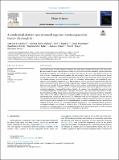Por favor, use este identificador para citar o enlazar a este item:
http://hdl.handle.net/10261/304674COMPARTIR / EXPORTAR:
 SHARE SHARE
 CORE
BASE CORE
BASE
|
|
| Visualizar otros formatos: MARC | Dublin Core | RDF | ORE | MODS | METS | DIDL | DATACITE | |

| Título: | A xanthophyll-derived apocarotenoid regulates carotenogenesis in tomato chromoplasts |
Autor: | D'Ambrosio, Caterina; Stigliani, Adriana Lucia; Rambla, José Luis CSIC ORCID; Frusciante, Sarah; Diretto, Gianfranco; Enfissi, Eugenia M A; Granell, Antonio CSIC ORCID; Fraser, Paul D; Giorio, Giovanni | Palabras clave: | Carotenoid metabolism regulation; CrtRb2; Fruit ripening; Lcyb; Transgene over-expression; Zeaxanthin; hp3 mutation | Fecha de publicación: | mar-2023 | Resumen: | Carotenoids possess important biological functions that make them essential components of the human diet. β-Carotene and some other carotenoids have vitamin A activity while lutein and zeaxanthin, typically referred to as the macular pigments, are involved in good vision and in delaying the onset of age-related eye diseases. In order to create a zeaxanthin-producing tomato fruit, two transgenic lines, one with a high β-carotene cyclase activity and the other with a high β-carotene hydroxylase activity, have been genetically crossed. Ripe fruits from the resulting progeny contained significant levels of violaxanthin, antheraxanthin, and xanthophyll esters. However, their zeaxanthin content was not as high as expected, and the total level of carotenoids was only 25% of the carotenoids found in ripe fruits of the comparator line. Targeted transcript analysis and apocarotenoids determinations indicated that transcriptional regulation of the pathway or degradation of synthesized carotenoids were not responsible for the low carotenoid content of hybrid fruits which instead appeared to result from a substantial reduction of carotenoid biosynthesis. Notably, the content of an unidentified hydroxylated cyclic (C13) apocarotenoid was 13 times higher in the hybrid fruits than in the control fruits. Furthermore, a GC-MS-based metabolite profiling demonstrated a perturbation of carotenogenesis in ripening hybrid fruits compatible with a block of the pathway. Moreover, carotenoid profiling on leaf, fruit, and petal samples from a set of experimental lines carrying the hp3 mutation, in combination with the two transgenes, indicated that the carotenoid biosynthesis in petal and fruit chromoplasts could be regulated. Altogether the data were consistent with the hypothesis of the regulation of the carotenoid pathway in tomato chromoplasts through a mechanism of feedback inhibition mediated by a xanthophyll-derived apocarotenoid. This chromoplast-specific post-transcriptional mechanism was disclosed in transgenic fruits of HU hybrid owing to the abnormal production of zeaxanthin and antheraxanthin, the more probable precursors of the apocarotenoid signal. A model describing the regulation of carotenoid pathway in tomato chromoplasts is presented. | URI: | http://hdl.handle.net/10261/304674 | DOI: | 10.1016/j.plantsci.2022.111575 | ISSN: | 0168-9452 |
| Aparece en las colecciones: | (IBMCP) Artículos |
Ficheros en este ítem:
| Fichero | Descripción | Tamaño | Formato | |
|---|---|---|---|---|
| 1-s2.0-S0168945222004009-main (1).pdf | 3,62 MB | Adobe PDF |  Visualizar/Abrir |
CORE Recommender
PubMed Central
Citations
1
checked on 26-mar-2024
SCOPUSTM
Citations
1
checked on 23-abr-2024
Page view(s)
44
checked on 27-abr-2024
Download(s)
123
checked on 27-abr-2024
Google ScholarTM
Check
Altmetric
Altmetric
Artículos relacionados:
NOTA: Los ítems de Digital.CSIC están protegidos por copyright, con todos los derechos reservados, a menos que se indique lo contrario.
